- Bernard Preston homepage
- Chickens
- Simple Chicken Coops
Simple chicken coops
Simple chicken coops can be made at minimal cost using pallets.
I try to avoid crazes; like fashions, they are so bad that we have to change them every year. Do you remember the pet-rock?
And frankly, keeping chickens is no different; it requires considerable aforethought and planning before launching out into this new-fad.
This page was last updated by Bernard Preston on 6th May, 2021.
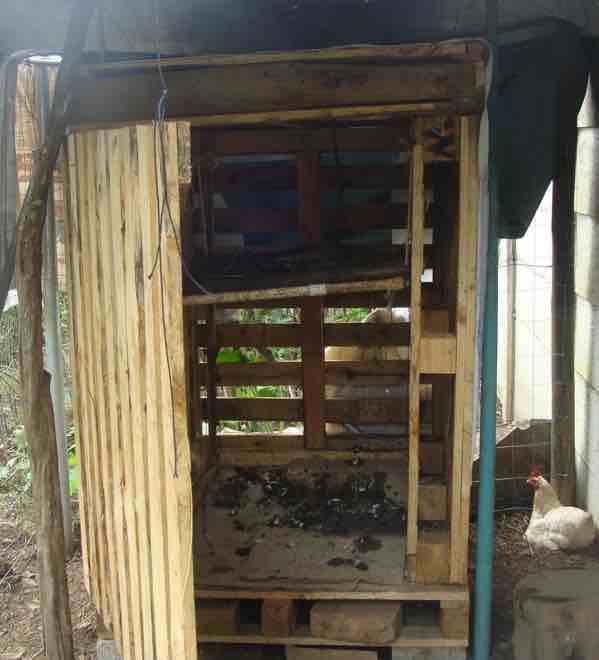
You can spend a lot of money purchasing, or building a chicken run from scratch. But have you considered that the hens have to be fed twice every day, and the coop cleaned a couple times a week?
Fresh water is easier with a container that needs filling and cleaning perhaps every five-days; still, it has to be done.
Then are you going to use your coop as a chicken-tractor? Something that will be moved around the garden every week to a fresh piece of ground. They will peck the earth clean within a few days and, hunting for grubs, manure it thoroughly, but they will destroy your seedbeds unless you have a plan.
- Bernard Preston homepage
- Chickens
- Simple Chicken Coops
Are you prepared to step in with a shovel, bent double and scrape all the chicken-litter out? Have you budgeted for extra visits to the DC?
The kits that you can purchase at a shop like Walmart look very pretty, starting at around $200, but they still have to be assembled; looking at them that will take several days I fancy, and you will need a few-tools. You are limited then to about four or five birds.
The Australian Taj Mahal comes in at $600.
Your hens will each provide about five-eggs a week if you feed them properly.
My advice is to first find out the value of real free-range eggs at the supermarket, if you can locate them, and the cost of feed.
These may turn out to be very expensive eggs that you soon find are far too onerous to produce, especially when the neighbours start to complain about the noise.
I am not trying to put you off, but unless you are in this for the long run, and plan to be into cage-free eggs for at least a few years, this will be just another craze that I recommend you forget before you start.
How many birds?
Just how many birds do you want to keep? And are you going to have a rooster for what the British call proper eggs; free-range and fertile. It depends on the breed but most folk seem to agree that one cockerel can cope well with about ten to twelve hens.
If you are breeding and want to be
sure that every egg is fertile then you may want to drop that number,
but otherwise if a few are not, does it really matter?
If you have a family of five, does it make sense to purchase a chicken-coop that will allow for a maximum of three or four birds?
Depending on a number of factors, you can work on about 4 - 6 eggs per week from each of your hens. Don't get me wrong, chickens in the garden have added a wonderful new dimension to our lives.
Might you want to expand and keep say eight hens as we have done? Then don't limit yourself by purchasing a craze chicken house from Amazon that looks very pretty initially, but seriously limits you. Those made in China get particularly bad reviews.
You will need some form of poultry drinker; this is very similar to mine and has proved very successful.
Simple chicken coops
Simple chicken coops give you free-range eggs; but unless they have easy access to fresh ground periodically you will have to feed them a large amount of greens in order to get the vastly improved nutrition that you will be looking for.
Cooped in is little different to commercial hens kept in a barn.
To my mind that is the only sound reason to get into this new craze. They are quite a lot of work; and much fun.
There are any number of options that you might consider. We started with a movable chicken tractor made from electrical conduit with a roost hanging up in the sky and covered with a tarpaulin.
It proved moderately successful but did not provide sufficient protection from the elements; mind you they do huddle together and can withstand considerable cold, but not wet.
We made do with the chicken-tractor for six months, and still use it, but long term it is not a satisfactory permanent home for your birds. Predators cleaned us out twice.
Then you could purchase a Walmart chicken coop; they have a maximum of two square metres of what you might describe as free range; but unless you move it periodically it will soon turn into a stinking desert. It will not deliver the nutritious eggs you are looking for, and provide for a crowded maximum of about five birds.
And then the third option is an enclosed run as small or large as you choose, with one of these simple chicken coops.
On the advice of an experienced egg farmer, I decided to build a chicken coop using five pallets, with a large hanging-door. It has been a great success.
It was really inexpensive with the pallets costing about four dollars each, made from rough, untreated-timber.
The whole structure, with heavy duty roofing plastic covering cost less than $50. Two really solid-hinges for the door were quite expensive.
Newsletter
Our newsletter is entitled "create a cyan zone" at your home, preserving both yourself and Mother Earth for future generations; and the family too, of course. We promise not to spam you with daily emails promoting various products. You may get an occasional nudge to buy one of my books.
Here are the back issues.
- Lifestyle and ideal body weight
- What are ultra-processed foods?
- Investing in long-term health
- Diseases from plastic exposure
- Intensive lifestyle management for obesity has limited value
- A world largely devoid of Parkinson's Disease
- The impact of friendly bacteria in the tum on the prevention of cancer
- There's a hole in the bucket
- Everyone is talking about weight loss drugs
- Pull the sweet tooth
- If you suffer from heartburn plant a susu
- Refined maize meal and stunting
- Should agriculture and industry get priority for water and electricity?
- Nature is calling
- Mill your own flour
- Bake your own sourdough bread
- Microplastics from our water
- Alternative types of water storage
- Wear your clothes out
- Comfort foods
- Create a bee-friendly environment
- Go to bed slightly hungry
- Keep bees
- Blue zone folk are religious
- Reduce plastic waste
- Family is important
- What can go in compost?
- Grow broad beans for longevity
- Harvest and store sunshine
- Blue zone exercise
- Harvest and store your rainwater
- Create a cyan zone at your home
We currently have eleven hens in it, with a rooster and some offspring; it is all in the planning. We want to have proper-eggs.
We had eight hens and a rooster, but the mongoose took two before I started looking at simple chicken coops.
This is not suitable if you have snakes that will attack the birds; they can slither through the gaps in the pallets, but it will keep larger predators like a mongoose, and even your own dogs at bay.
I chose pallets that are 1m x 1.2m long; it is about right, but you could make it bigger. You will need a spirit-level.
First, lay out four concrete blocks for the corners, getting each level and square.
Place your first pallet on the blocks.
It is then really very simple to place three pallets for sides, and a back, and another on top for a roof; using 4" nails hammer everything securely in place. I used a couple of six-inch too just to be certain. A large square helps to get it ship-shape, or the door will not fit.
Cover the whole structure with heavy-duty roofing plastic, including the sides and back. A staple gun makes it very secure and simple.
Door

Your simple chicken coops must have a secure door, of course. Measure up the size of the gap, lay out the struts leaving a space of no more than about an inch; find two cross-pieces and a diagonal and glue and screw it securely.
Two strong-hinges and a clasp complete your chicken coop; simple, eh?
Even though it is made of rough, untreated timber, out of the rain I figure it will last at least five years. Pallets are sturdily made for obvious reasons and your hens will not notice if it is not finely-planed and finished.
In total, it took me less than a morning to assemble. And, as I update this page, it is more than five-years old and looking perfect. I have made a second for sitting-hens.
Roost

Your hens won't like sitting on the ground all night of course; simple chicken coops must also have a roost. Drill holes through the conduit at say 10cm intervals and wire the sticks firmly in place; they should be at least an inch thick.
Suspend the whole structure firmly inside your simple chicken coop, about 18" from the ceiling. Use strong nylon; with eight or more birds it will be quite heavy.
One of my older hens is unable to fly up into the coop so I've place a log for her on the ground. It is interesting that at three-years old she is still laying five eggs a week; that's because of premier best feed; we use sprouted corn for chickens.
We are about to get non-GM maize. I'm told the hens love it, and we are about to buy a mill so we can enjoy it too.
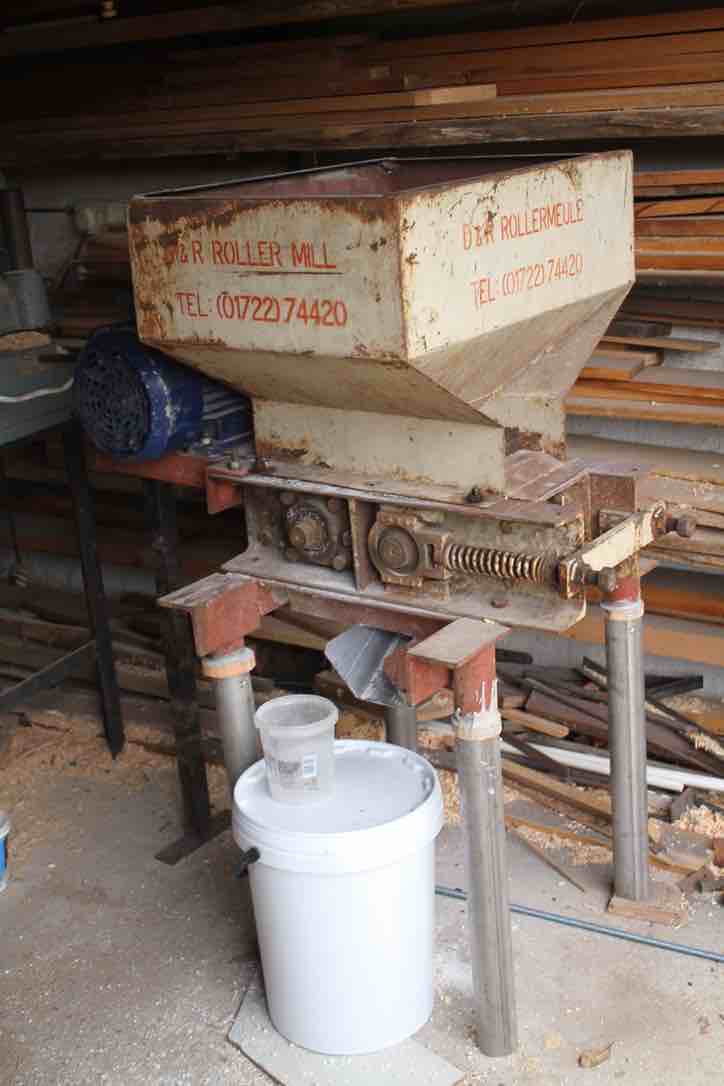
Slowly you may find your hens start to take a place of eminence, demanding more of your time, and new toys like this very old roller-mill. Now the food cost is halved with corn coming straight from the farmer.
Line the sides
It may be important to line the sides, and the ceiling for that matter, to prevent the creatures of the night getting into your simple chicken coops.
A baby chick was mystifyingly vanishing without a trace every night. Eventually the intruder left some scat behind but is still an unknown beastie; he did not take the mother or eggs for that matter. I have had to line the sides with chipboard.
There are lots of chickens but the wildlife is increasingly scarce as humans treat Mother Earth with such disdain; but not in my backyard, please, Mr Mongoose.
Non-lethal predator control at our level, consists of simply making absolutely sure the nocturnal creatures cannot gain access to our simple chicken coops; they visit every night waiting for me to be forgetful.
During the day, the chickens have access after laying to a large area that is well sheltered with thick bushes where they can hide from aerial-predators. Out in the open they are fair game for the birds of prey.
Taj Mahal chicken coop
Alternative to simple chicken coops you can spend R10,000 ($600) on the Taj Mahal, plus courier charges and six weeks of assembly according to the manual!
It's very pretty, I must admit; fit for an Indian-raj, but are you even going to have a cockerel to strut about and rule over his fiefdom?
Free range eggs
With their deep orange yolks, free range eggs make the most delicious eggs Florentine; it tops the list of a nutritious, scrumptious breakfast.
Another firm favourite is this lima bean shakshuka; you could make it with canned butter beans but it's a pale shadow of the real McCoy.
Hens need a lot of calcium from their food and the shells from their own eggs, suitably disguised, make the perfect source.
Can you feed eggshells to hens? Certainly you can.
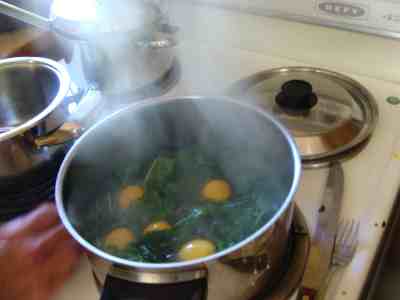
Free-range eggs with their deep orange yolks are a nutritional delight, rich especially in choline and omega-3 fatty acids. But to have them you will need one of these simple chicken coops.
We get six or seven free range eggs most days; now and again only five. That is from seven hens.
I will get another photo this evening with the hens in situ. Just before dark you will find them sitting happily in your coop, waiting for you to lock them up for the night.
Deciding what is going to be the best chicken feed for your hens is obviously dependent on whether they can wander in the garden; that is where they will find the protein for your delicious free-range eggs. Cutworms, beetle larvae, grasshoppers and the myriad of tiny creatures in a compost heap then give them a well-rounded meal, on top of the many weeds they will nibble at.
Betaine is an important component of best chicken feed. You will find they will gravitate to the spinach in your garden, and best of all any bread made with 100 percent flour will drive them crazy with desire.
What is betaine is a question you should be able to answer.
Careful planning of the vegetable garden needs then to be done; ours is divided into five sections. The hens are only allowed into an area where the plants are well established; they scratch out seedlings with abandon hunting for worms in the compost you have used.
Keeping them well away from the bush beans is important; vegetable protein is right up their street and they will demolish them. If starved of greens they'll get stuck into your kale and broccoli too. Right now they are wandering in the corn where they do no damage after the plants are about 6" high; and provide copious manure obviously.
At times, for a few weeks whilst seedlings are vulnerable, they'll be sent back to our first chicken tractor design; the next will be smaller and lighter.
We also supplement their food with a bucketful from the worm farm once a week; that's Christmas.
The wonder of worm farms goes synergistically with your hens.

Testing eggs for freshness
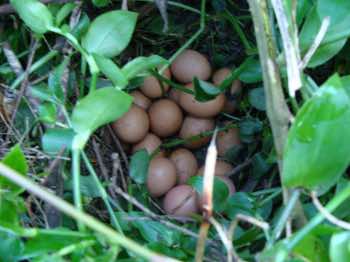
Periodically one or two naughty hens will spurn the nest you provide; then you need to be adroit at testing eggs for freshness.
I now let them out of the simple chicken coops early for an hour, and then keep them in the run until about 10 o'clock when most of the eggs have been laid.
Chicken coops for broodies
Chicken coops for broodies is next on the agenda, There seems to be an inevitable progression of events in green living; there's never a dull moment.
My granddaughter wants us to raise chicks.
A broody hen, and her chicks have to be kept initially separate from the rest of the flock who will disturb her and lay in her nest. We are keeping Togo's eggs back, learning about candling, and have built her a private home of her own.

The gate is all welded and ready to erect; the roost needs to be covered in plastic to keep the rain out, and a door to keep the mongoose and genet at bay. Soon Togo, the Australorp, will be able to brood in peace; we are already collecting her eggs.
You can spend a lot of money, but I am very happy with simple chicken coops; the birds are flourishing too. With another broody hen we are about to start building another.
Eventually I boarded up the inside of the coop completely; an unknown nocturnal predator took the chicks.
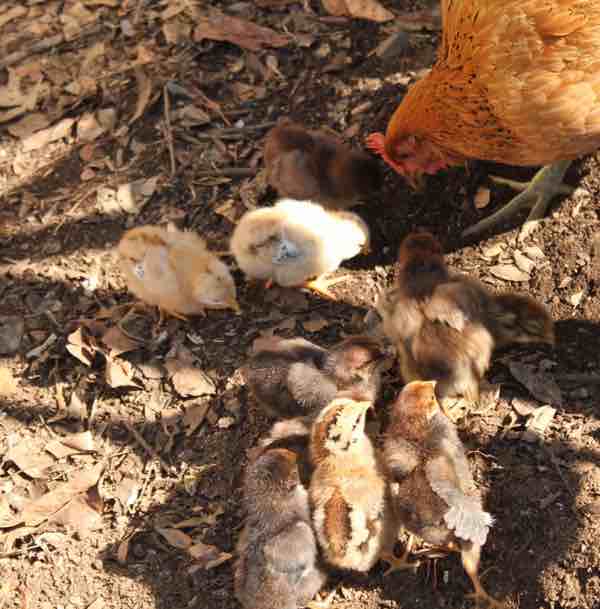
Most difficult is that half of the precious little gems will grow up to become raucous, rapacious roosters; they torment the hens constantly. Off with their heads is a new theme at our home; not for the faint-hearted, but goodness the meat is tasty and tender.
It is the genuine article. What do you think when you see the word organic on food at the supermarket these days? Often it's a big con.
Spring of 2019
It's spring and suddenly we have three broody hens. The first produced eight chicks from her eggs, the second none, and the third is sitting in a grass catcher box in our simple chicken coop with the rest of the birds just above her. It is not ideal.
We are desperate for space and she will be moved before they hatch, probably to the chicken tractor. More recently I have made three predator-proof boxes for the broody hens. It's been a great success. You do have to keep them clean.
It's now nearly seven years since the first hens arrived; it has certainly been a lot of fun, hard work and a fair amount of heartache. Knowing what I now know, I would certainly do it over again.
But I won't kid you; it has been a fair amount of hard work.
Did you find this page interesting? How about forwarding it to a friendly book or food junkie? Better still, a social media tick would help.
- Bernard Preston homepage
- Chickens
- Simple Chicken Coops
Address:
56 Groenekloof Rd,
Hilton, KZN
South Africa
Website:
https://www.bernard-preston.com